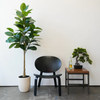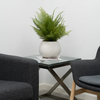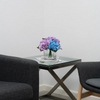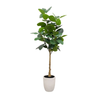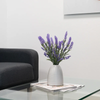Do Interior Designers Use Fake Plants?
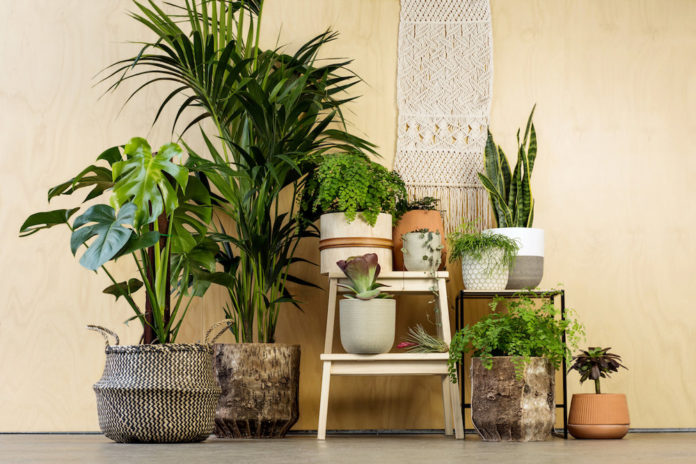
In the world of interior design, style and practicality often go hand in hand, and more and more designers are embracing the timeless charm of fake plants in home decor. Whether in a minimalist loft or a cozy cottage, these elegant accents offer a refreshing touch of nature without the upkeep real plants demand. Interior decorating with artificial plants allows for creative freedom, as no sunlight, watering schedule, or seasonal changes are needed. Instead, designers can focus purely on balance, texture, and beauty.
Faux greenery has become a go-to choice for its versatility and ease. From lush ferns on a bookshelf to delicate stems gracing a dining table, realistic faux plants can bring a space to life with minimal effort. Today's designs are so finely crafted that even the most discerning eye might not tell the difference. Unsurprisingly, interior designers are turning to faux options that blend elegance with lasting appeal.
Which Is Preferred: Live Or Artificial Plants In Interior Design?
When choosing between live and artificial plants in interior design, the decision often depends on the lifestyle and needs of the space. Live plants offer natural beauty and can improve air quality, but they also require consistent care, the right light conditions, and occasional repotting. This maintenance level may not always be practical for busy homeowners or commercial settings.
That’s where artificial greenery in interior design come into play. With today’s high-quality materials and lifelike details, faux plants provide a lasting, low-maintenance solution that still captures the essence of natural greenery. They work beautifully in spaces with low light or heavy foot traffic and stay vibrant all year round without fading or wilting.
Designers often mix real and faux elements to create a balanced, curated look. Ultimately, the choice depends on the environment and the level of care one can provide.
Advantages Of Choosing Fake Plants In Home Decor
Incorporating fake plants in home decor is a thoughtful way to bring natural beauty into your space without the challenges of caring for live greenery. With modern craftsmanship, faux plants offer a lifelike appearance and lasting charm that suit any style or setting. Here are some of the key benefits:
- Low Maintenance: There is no need for watering, pruning, or sunlight. Faux greenery stays fresh and vibrant without daily attention, making it ideal for busy households or second homes.
- Long-Lasting Beauty: Realistic faux plants retain their color and shape for years. Unlike organic plants, they won’t wilt, shed leaves, or fall out of season.
- Allergy-Friendly: Artificial plants are a perfect choice for anyone sensitive to pollen or mold, offering a clean and safe way to enjoy greenery indoors.
- Versatility in Placement: Because faux plants don’t rely on light or humidity, they can be placed anywhere—from dim hallways to high shelves and even windowless bathrooms.
- Cost-Effective Over Time: While the initial investment may be slightly higher, fake plants do not require ongoing costs for care, replacement, or pest treatments.
- Style Consistency: Decorating with artificial plants in the interior ensures that your decor maintains a consistent, polished look no matter the season.
- Creative Freedom: Mix and match styles, colors, and arrangements without worrying about plant compatibility or survival.
Trendy Faux Greenery Interior Designers Love For Their Projects
Fake plants have become a popular design choice in modern interiors, thanks to their refined appearance and practical benefits. Designers appreciate how these elegant replicas bring beauty to a space without the care required by live greenery. From timeless classics to contemporary favorites, here are some of the best fake plants for interior design that capture attention in high-end projects.
Olive Tree
The faux olive tree is a favorite in modern spaces for its graceful, slender branches and soft green tones. It lends a relaxed Mediterranean charm and works beautifully in minimalist or rustic interiors. When comparing artificial plants vs real plants, olive trees are a clear winner in faux form due to their low maintenance and ability to stay lush without full sun. Designers often place them in oversized planters to anchor a room with natural elegance.
Orchids
Orchids exude sophistication, and their faux versions are nearly indistinguishable from the real thing. These delicate blooms make a striking statement on consoles or dining tables. Using fake plants in modern interiors allows for exotic touches like orchids without the need for precise humidity and lighting. As one of the best fake plants for interior design, faux orchids offer enduring grace, ideal for classic and contemporary spaces.
Succulents
Faux succulents bring texture and charm in compact, stylish forms. Perfect for desktops, shelves, or small nooks, they complement a range of decor styles. The appeal of artificial plants vs real plants is clear here—no watering, no sun, and no mess. Designers love using succulents in clusters or mixed arrangements to create a low-key yet curated look that adds depth to modern interiors.
Topiary
Topiary adds structure and elegance, often seen in symmetrical designs or entryways. Faux topiaries maintain their shape year-round, offering formal beauty without the upkeep real versions demand. When used in modern interiors, topiary stands out as classic and polished. These sculpted greens are among the best fake plants for interior design when aiming for a tailored, timeless aesthetic.
Desktop Lavender
Faux lavender brings a hint of color and a soft, rustic feel to workspaces and cozy corners. It’s a lovely choice for desks, bedside tables, or bookshelves. Lavender shows clear advantages with artificial plants vs. real plants—no need to worry about wilting blooms or watering schedules. Lavender is subtle yet effective in creating a serene mood, making it a go-to for relaxed, elegant interiors.
Peony Arrangements
Lush, romantic faux peony arrangements are favored for their full blooms and rich colors. They make stunning centerpieces or accent pieces in bedrooms and sitting areas. When used in modern interiors, peonies deliver drama and softness in equal measure. As one of the best fake plants for interior design, they offer luxury without the fleeting nature of real floral arrangements.
Artificial Ferns and Bonsai
Ferns and artificial bonsai trees add a refined natural element, especially in tranquil or Zen-inspired spaces. Their faux versions require no trimming or humidity, making them perfect for indoor use. Artificial plants vs real plants becomes an easy choice here—consistent shape, lasting beauty, and zero maintenance. Interior designers value their intricate detail and adaptability, especially when looking for greenery that adds quiet sophistication to a room.
How do Designers Style Fake Plants?
Designers approach faux greenery with the same care and creativity as any decor element. With many lifelike options available today, interior decorating with artificial plants has become a staple in creating inviting, elegant spaces. Here’s how designers style fake plants to improve modern interiors.
Layering and Texture
Designers often layer different types of faux greenery to add depth and interest. Pairing tall leafy plants with low arrangements or mixing structured topiaries with soft cascading vines creates a natural, curated look. This method is perfect for using fake plants in modern interiors, where clean lines are softened by organic forms.
Strategic Placement
Placement is key in styling faux greenery. Designers tuck small plants onto open shelves, place trailing vines on cabinets, or use large trees to fill awkward corners. In rooms lacking natural light, artificial plants provide greenery where real ones would struggle, highlighting their advantage over real plants.
Choosing the Right Containers
The container often transforms the plant’s look. Designers select pots that complement the room’s style—ceramic for classic settings, woven baskets for cozy corners, or sleek metal planters for contemporary spaces. This small detail significantly impacts the execution of refined fake plants' interior design ideas.
Mixing with Natural Elements
Even when using artificial plants, designers often combine them with real materials like wood, stone, or linen. This blending adds authenticity and balances the space visually, creating harmony between the natural and the crafted.
Faux greenery, when styled thoughtfully, brings both character and ease to any room. Interior decorating with artificial plants offers endless options for beauty without the fuss, making them a designer favorite across all styles.
Wrapping Up
Faux greenery has earned its place in modern design, offering timeless style, low maintenance, and year-round beauty. Whether you're drawn to the elegance of orchids or the charm of a desktop lavender sprig, using artificial plants in your home brings warmth and sophistication without the upkeep. Creating a beautiful space has never been easier with so many options available.
Looking for pieces that blend seamlessly with your decor? Visit fakeflowers.com to browse a curated collection of high-quality, realistic faux plants perfect for every room. Bring home lasting beauty without compromise.
FAQs
1. Do interior designers use fake plants in their projects?
Yes, many interior designers regularly use fake plants in their projects. High-quality faux greenery offers lasting beauty, requires no maintenance, and fits seamlessly into various styles. It’s a practical and stylish solution, especially for low-light spaces or busy clients who prefer low-effort decorating options.
2. Why would an interior designer choose artificial plants over real ones?
Artificial plants are chosen for their durability, versatility, and ease of care. Unlike real plants, they don’t need sunlight, water, or special attention. Designers appreciate that faux greenery maintains a polished look year-round, making it a reliable choice for residential and commercial interiors.
3. Are fake plants considered stylish in modern interior design?
Absolutely. With advancements in design, fake plants now look incredibly realistic and are embraced in modern interiors. They add texture, color, and life to a room without the unpredictability of live plants, aligning perfectly with today’s desire for beautiful, functional, and low-maintenance decor.
4. What types of fake plants are best for interior design?
Popular options include olive trees, orchids, ferns, succulents, and bonsai. These styles offer elegant shapes and lifelike detail, making them ideal for various design themes. Desktop lavender and peony arrangements are also loved for their soft, refined look that uplifts bedrooms, offices, and cozy nooks.
5. Can you mix real and fake plants in interior design?
Mixing real and fake plants is a common and practical design approach. It allows for natural beauty with added convenience. By blending both, designers create a balanced look—real plants bring freshness, while faux pieces offer stability and structure in areas less suited for live greenery.
